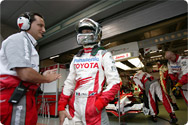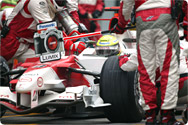Thank you, as always, for your support. Here is my report from the Chinese GP, which turned out to be a very tough battle for us throughout the entire race weekend.
 |
 |
| The TF106B made its appearance at the Chinese GP sporting a new aero package. The team made major changes to the engine cowl and surrounding sections. |
|
 |
Updated specification looking toward the Japanese GP
With just three races left in the season, we came to Shanghai with the feeling that we really wanted to do our best. Changes to our car included the engine exhaust system, engine cover and front wing.
We changed the shape of our exhaust to make the system tighter for aerodynamic improvement. We were able to make these changes since Panasonic Toyota Racing performs both engine and chassis development under the same roof, and the changes we made to the exhaust were made in pursuit of added aero performance. The development process entailed some difficulty, but we worked hard to make the changes in time for the Japanese Grand Prix. The new slim design of the engine cover should be fairly obvious to the viewer.
| |
 |
 |
Looking at the TF106B from behind, one sees that the already sharply angled engine cowl has been slimmed down even further. |
 |
The front wing has changed as well, but the extent of the changes amount to fine tuning, which might not be noticeable at first glance. Changes in the exhaust system, engine cover and front wing, although not major in scope, have helped improve performance.
Last year, Ralf started P9, finishing 3rd in the race, and recording a very quick fastest lap in the process. At that time, we had implemented a fairly strong downforce setting, allowing Ralf to save time over Sector 2, a particularly low-speed section of the course. The issue for this year was how much we would orient our settings toward top speed.
At the mercy of sudden rain showers on Friday
During the morning, we conducted our installation (driving laps to check the car's functions) as we always do. Our intention was to use the afternoon session to adjust our setup. Since there was only a 25% chance of rain, we didn't expect any precipitation, but around one o'clock someone announced "it's raining!" and we went into a frenzy of activity to prepare for the conditions.
Usually our afternoon session consists of conducting long runs while changing our setup two or three times, but on this day we were only able to do our tire comparisons, unable to make it as far as finishing work on our setup. After a long run, we made some minor adjustments for Ralf, but we didn't even make it that far for Jarno. It rained just as was forecast, and Jarno was only able to run a few laps on intermediate tires.
We tested settings with a focus on aerodynamics, but the course conditions caused heavy tire wear. We changed the wing angles and tried other adjustments, but conditions wouldn't allow us to really test balance changes.
Our data indicated that adding downforce certainly allowed us to attack Sector 2, a section featuring many corners. If saving time was the only concern, we could focus on our attack of this section, but considering the race, we believed it would be more advantageous to emphasize Sector 3, which has more straights. We made the decision to wait until Saturday before making our final assessment.
Inconceivably, both cars fail to make it out of Q1; learning from the experience
We planned to complete the rest of our program from the prior day during free practice on Saturday morning, but we changed over to a wet setting based on the rainy conditions. The problem was that as of Saturday, the race-day weather was a 50/50 proposition, with forecasts indicating that the first part of the race would be wet, slowly improving during the race. Given that, we decided to make our front wing adjustments from a fundamentally "dry" setting.
 |
 |
| Having failed to proceed beyond Q1, Panasonic Toyota Racing decided to incorporate certain risks into their race strategy. Jarno goes through final checks before the start of the race. |
|
 |
Several different incidents occurred during qualifying, but the entire experience was truly disappointing. We had problems with the timing of our time attack laps, but I believe the overriding issue was a general lack of overall performance capacity. Looking at the fine details, there were issues of understeer here and there, as well as heavier rain showers at certain times that caused us problems.
We started on used tires during Q1 (first qualifying session) to conduct our installation laps. We confirmed the cars were functioning, changed to new tires and went back out onto the circuit. Our first lap (measurement lap) turned out rather poorly, and then the red flag came out just as we began our second lap. The wet conditions made it very difficult for us to drive any single lap perfectly. The same could be said for all of the other teams as well. With a definite possibility of rain at Suzuka next week, we want to take the results from this race and use them to develop an effective rain strategy for our team.
A bold approach to the race, understanding the risks involved
The race also turned out to be a big disappointment for us. According to the weather reports, it was supposed to rain until about 12:30 p.m., and then stop after that. The track was wet at the start of the race, but our strategy reflected our expectations that the surface would dry out during the race. The problem would be if there was no wind or sun to help dry the track out quickly. In that case, the decision of when to change from wet to dry tires would be extremely difficult.
Usually, the Shanghai circuit is a two-stop race. Considering the state of the drying track, we figured that it would be time to change over to dry tires on the second pit stop, if things went well. That was the basis of our strategy, so we decided to adopt a bold stance, loading enough fuel at the first pit stop to last to the end of the race, and changing over to dry tires at the same time.
| |
 |
 |
Ralf, marking the fastest lap time after changing to dry tires in the pits. Unfortunately, the race ended in a fashion that prevented the team from knowing whether their strategy was successful. Arai DTC looked back on the race believing that the risks were worth the attempt. |
 |
About four or five laps prior to the first stop, the pits and the drivers discussed what tires to go with. The drivers responded that it might be premature to go with the dry tires, but the final decision was to acknowledge the risk, but throw down the gauntlet. We plunged forward with the decision to change to dry tires.
In the end, our timing for the change to dry tires proved to be too early, but changing the tires at the same pace as the other teams would have just left us in the same position we started, so I think we made the right choice. Ralf was able to pick up the pace about five laps after changing to dries, and he was able to record the fastest lap to that point. While we didn't get the results we were looking for, I think it was worth the risk.
Jarno retired early from the race with pneumatic (system that drives engine valves with air pressure) trouble, and Ralf retired early due to a loss of engine oil pressure. While the two "DNF" results were very disappointing, I think we came away happy with the results of our aggressive approach to the race. Both I and the Panasonic Toyota Racing team want to do everything in our power to show our fans the true capability of our cars at the upcoming Japanese Grand Prix.
|